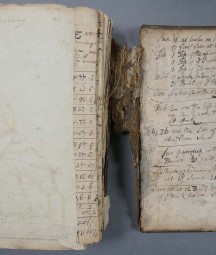by Avice-Claire McGovern, Librarian
Eyewitness accounts from Tuesday, 9th May 1916
On Easter Monday, 24th April 1916, Alfred West was attending the Irish Grand National at Fairyhouse, when he heard about the outbreak of the Easter Rising in Dublin. He decided to leave early and, not thinking that things were as serious as reported, drove through the city centre where he found himself caught up in the fighting. He saw dead horses on Sackville Street and all the windows in the General Post Office smashed. Fearing for his safety, he hurried over to the Kildare Street Club where, only a few hours earlier, Granby Burke had been having lunch with a friend when he heard news of the outbreak of the rebellion. On Tuesday, 9th May 1916, both men wrote letters to Captain Cecil Fetherstonhaugh and his wife Meriel at Bracklyn Hall, County Westmeath, giving an account of their experiences in Dublin during the Easter Rising.
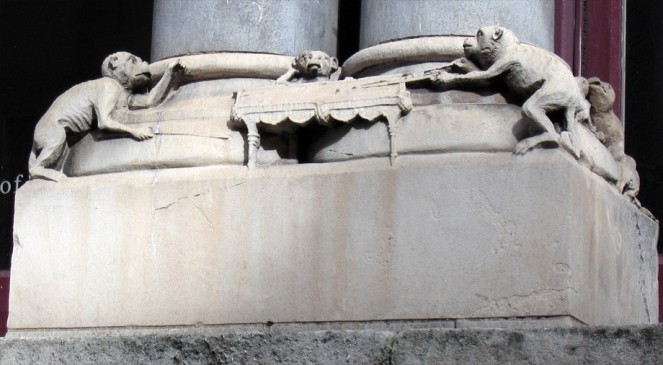
These billiard-playing monkeys outside our Department of Manuscripts reveal the building's antecedents as a club for gentlemen - The Kildare Street Club. Thanks to Mary Mulvihill of Ingenious Ireland for this photo.
The Department of Manuscripts, where I work, is situated directly above the former Kildare Street Club, and when I was given these two letters to catalogue, it was exciting to discover a direct connection between the Club and the Easter Rising. Another interesting aspect is the insight the letters provide into the immediate attitudes of members of the Irish public (albeit from specific classes and backgrounds) to the Easter Rising. They evince anger at the lives lost and the damage done. However, there are differences in tone: while one letter (West’s) is full of indignation at what has happened, the other (Burke’s) is more matter of fact, although he does describe his distress at the plight of innocent people caught up in the rebellion. The letters also connect two simultaneous conflicts – the vast upheavals of the First World War and the events in Dublin, the latter conflict more local but no less momentous than the former for the Irish people.
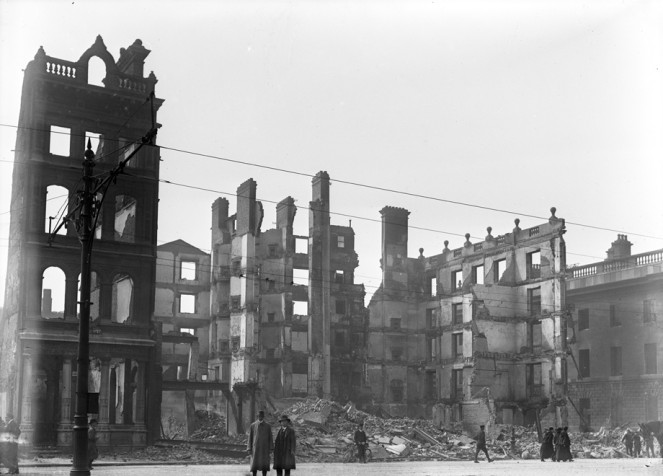
Just one of the photos in our collections that show the scale of devastation after the 1916 Rising. These are the skeletal remains of the Metropole Hotel on Sackville Street (now O'Connell Street). The side wall of the G.P.O. is visibly at extreme right. NLI ref.: Ke 110
Alfred West’s Letter (MS 49,365)
Alfred West (1851-1919) was from Kilcroney, County Wicklow, and lists his occupation as “gentleman” in the 1911 census. He held the office of High Sheriff of County Wicklow in 1915. He addresses his letter to Captain Cecil Fetherstonhaugh and expresses concern about Fetherstonhaugh who had also been at the races at Fairyhouse at the outbreak of the rebellion: “we were also anxious to hear how you got home”. He asks about the “state of the country about Bracklyn, it being so isolated”. West's anger becomes particularly apparent when he writes "... if they had got a little more rope the brutes would have destroyed all & everything ... a couple of nights could see them signalling with lamps from close here to a hill just behind Kilcroney and then on to a point on Sugar Loaf, from that no doubt they sent word on to Wexford”. He goes on to refer to “a great number of Sinn Feiners” in Bray and the lack of [British] troops there.

''... there was a large crowd just by Nelson's Pillar a very bad looking lot ...'' from page 2 of Alfred West's letter. NLI ref.: Ms. 49,365
West then writes about his own journey home from Fairyhouse: “we fortunately were one of the first cars away. Came through Sackville St. not thinking things were as bad as they were, but heard as you did, that they had the post office”. He mentions the dead horses on Sackville Street and the damage done to the GPO: “all the windows had been smashed and chairs & tables stuck up in them, saw several armed men in their shirt sleeves ... went to Kildare St. Club found the front door shut but got in by the side one, & found out that Stephen’s Green was held, and that they were shooting”. When he went up to the Shelbourne Hotel to see what was going on, he saw two bodies, one of a man that had been shot dead and the other a doctor who had gone to the man’s aid. Alfred West goes on to say that on Wednesday [26th April 1916] he and Frank Jameson drove up to Baggot Street Bridge and helped with the wounded soldiers: “at Baggot St. Hospital they asked us for the motor car to bring some wounded soldiers in, which we did”.
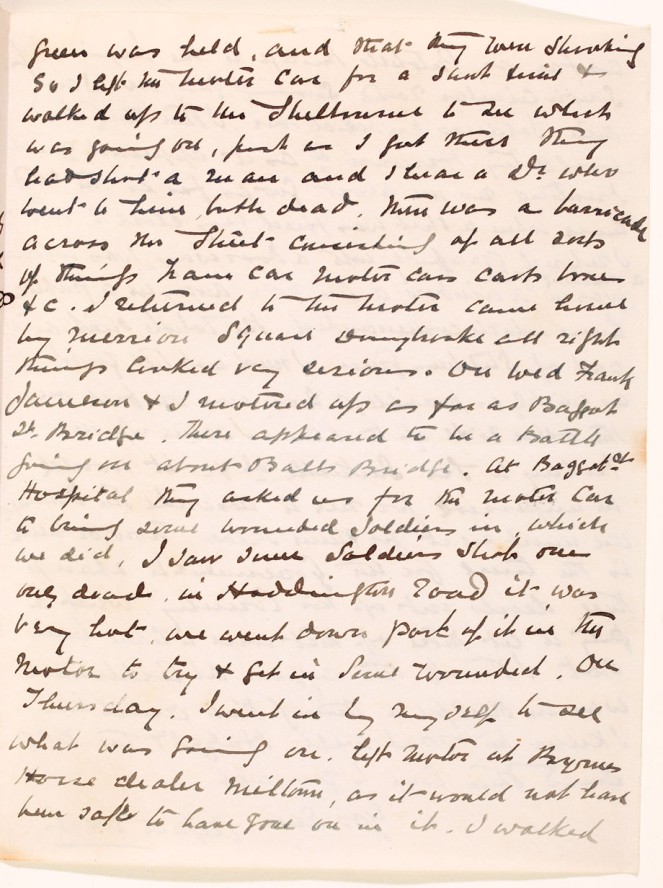
... There appeared to be a battle going on about Ballsbridge... from page 3 of Alfred West's letter. NLI ref.: Ms. 49,365
West returned by himself the next day [Thursday 27th April], leaving his car at Milltown as “it would not have been safe to have gone on in it”. He walked as far as Portobello Bridge to the beginning of the South Circular Road, before deciding, “as it appeared quiet”, to walk over to Harcourt Street: “I noticed no one about. Got as far as the [end?] house when a shot was fired very close to me”. At this, he hid in a doorway and was informed that “a machine gun was in a window a few yards away in a public house which commanded the whole street and part of Stephen’s Green”. On Friday [28th April], West visited Sackville Street, of which he writes: “It would be impossible for me to describe the damage. One must see it for themselves [sic]”. He mentions that “now or never is the time for the government to stamp these devils out of the country. What a pity to let those off that were to have been shot. The affair at Ashbourne was as dreadful a thing that could be. I knew the spot well”. The “affair at Ashbourne” is a reference to the storming of the Ashbourne R.I.C. barracks by rebels who were sent there to ambush army officers returning from the races at Fairyhouse.
In a postscript, Alfred West writes “I hope you have good news of Ashley”, enquiring after Fetherstonhaugh’s son Captain Ashley Fetherstonhaugh who was away fighting in the First World War. Ashley was tragically killed on Thursday, 20th March 1919 after his motorbike collided with a train on a level crossing in Co. Cork, Ireland.
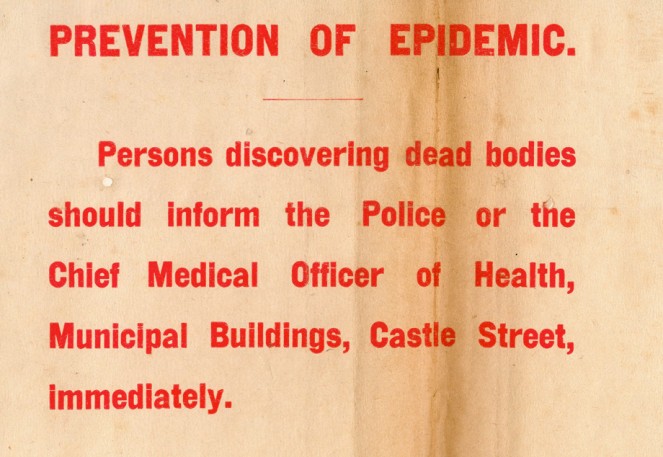
Fearing an outbreak of disease, this handbill was issued by the Administration in Dublin Castle. NLI ref.: POL/1910-20/2
Granby Burke’s Letter (MS 49,366)
Granby Burke was a member of the Four Courts St. John Ambulance Brigade, and happened to be on ambulance duty during Easter Week. His letter is addressed to “My Dear Mrs. Cecil”, meaning Meriel Fetherstonhaugh [wife of Captain Cecil Fetherstonhaugh]. He writes on behalf of Agnes [his wife?] who, he explains, had “asked me to answer your kind letter as she is overwhelmed with correspondence from anxious friends”. Burke describes how he heard of the outbreak of the rising: “I had a young soldier ... on leave from Salonica [where the British Army were fighting against the Bulgarians and Austrians in the First World War] lunching with me at Kildare St Club on Easter Monday, and then heard of the outbreak of the rebellion”. He mentions that “for a week from that day, no bread or milk were [sic] delivered, and the butcher shops were shut. Butter went to 7/- per lb. All the gas in Dublin was cut off on Tuesday [25th April 1916], and is not on again yet”.
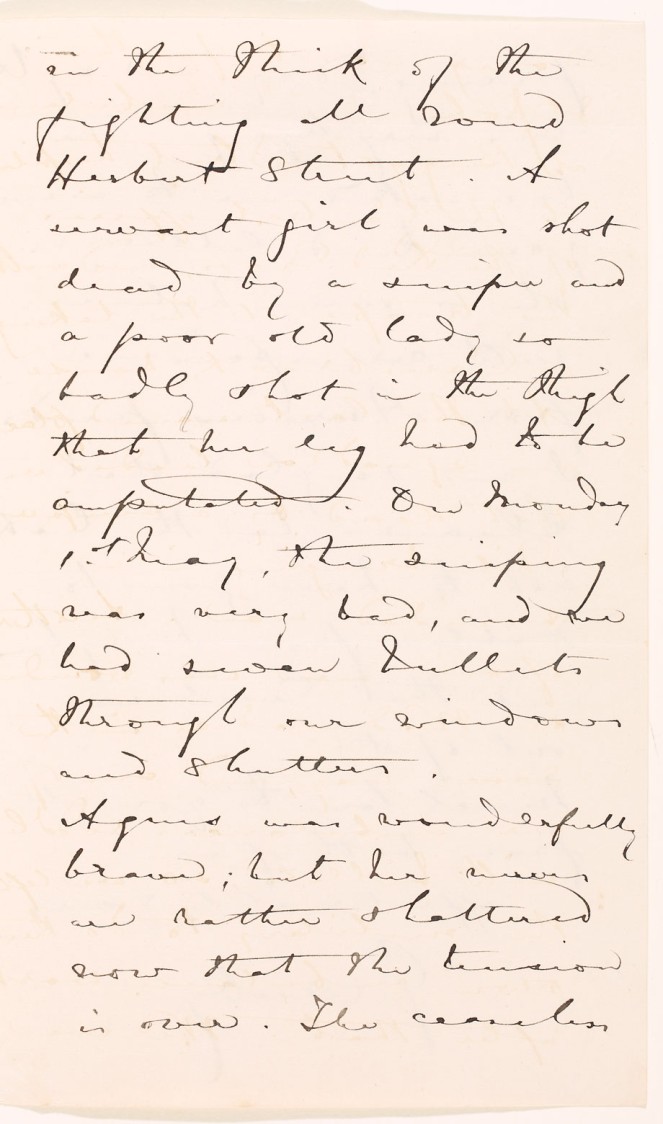
... On Monday 1st May, the sniping was very bad, ... bullets through our windows and shutters ... from page 3 of Granby Burke's letter. NLI ref.: Ms. 49,366
Granby Burke goes on to describe his work with the St. John Ambulance at Baggot Street Hospital, and his experiences at “the taking of Carisbrook House” where “our squadron leader was shot dead by a sniper, while bringing in a wounded man” (Carisbrook House was one of the buildings in Dublin seized by the rebels). He mentions also that “another of our men was wounded … and one of our ambulances riddled with bullets; so we left the military to do their own ambulance work after that. We were in the thick of the fighting all round Herbert Street. A servant girl was shot dead by a sniper and a poor old lady so badly shot in the thigh that her leg had to be amputated”. He says that Agnes has been “wonderfully brave” but that “her nerves were rather shattered now that the tension is over. The ceaseless firing day and night, was very trying”. Burke adds that he is relieved that “Eleanor [Captain Cecil Fetherstonhaugh’s daughter] had the luck not to have gone to Dublin from Fairyhouse, and that Cecil [Captain Cecil Fetherstonhaugh] was out of it”. In the aftermath of the rebellion, Burke was awarded a certificate of honour for his bravery.

View from the back of the G.P.O. on Henry Street towards Nelson's Pillar on Sackville Street (now O'Connell Street). NLI ref.: Ke 111
Captain Cecil Fetherstonhaugh
Captain Cecil Fetherstonhaugh was the High Sheriff of County Westmeath. His father Howard Fetherstonhaugh was murdered on his way back from Dublin in April 1868 for his tough policies during the Land Wars – he was very unpopular with his tenants and had raised rents forcing them off the land. Cecil was also a cousin of T.E. Lawrence (the famous Lawrence of Arabia). His father’s aunt, Margaret Anne Fetherstonhaugh, was Lawrence’s great-grandmother.
